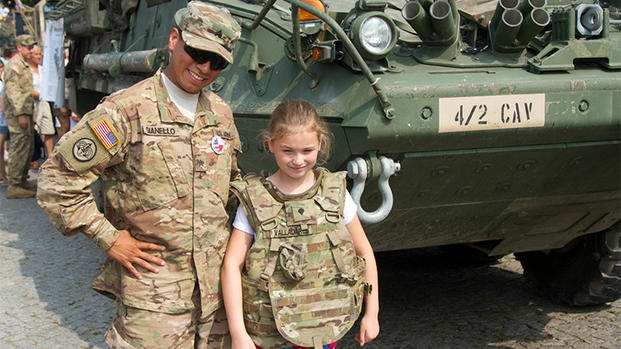In my time wandering around the internet, I come across many discussions and questions regarding the amount of family support that a military member is required to give their spouse and/or children during a separation or a deployment. Obviously, this is a hot topic and there is a lot of emotion involved. The good news is that there isn't a lot of guesswork involved: every service has some sort of regulation that addresses this issue. The bad news is that the guidelines aren't always completely clear, nor are they absolute. Enforcement is typically up to the chain of command, and there are compensating factors to be considered.
In general, service members are required to provide some level of support to their families. The details vary markedly between the services, though, so be sure to get the right information for your branch.
There are a few things to keep in mind. First, any court order or legal agreement will override the guidelines of the service. There are extenuating circumstances that will override the guidelines. Also, these guidelines are designed to address temporary needs while the parties pursue the appropriate legal services and come to some sort of agreement outside of the military.
These regulations are not designed to be used as permanent requirements. Rather, they are intended to encourage the service member and the spouse to seek permanent court or administrative judgments on the subject of support. The military services do not create these regs to be used in place of appropriate civil judgments, but rather to bridge the time between separation and legal action. It is in both parties best interest to come to an outside agreement or pursue the issue through the civil courts or administrative departments.
Air Force
I'm starting with the Air Force for two reasons: it comes first in the alphabet, and it has the shortest (and least clear) guidelines. Air Force Instruction 36-2906, Personal Financial Responsibility states that commanders are to "Advise members of the Air Force policy that they are expected to provide adequate financial support to family members and the procedures which the family member may implement to obtain involuntary collection of support through garnishment or statutory allotments." (Paragraph 3.2.1)
The 2021 update to the regs includes a formula for determining how much support should be given when the service member is receiving Basic Allowance for Housing with dependents, or any other allowance based on family support. It does not apply to dual military couples.
The Air Force formula is based on Non-Locality BAH, sometimes called BAH II, at the "with dependents" rate. Basically, you take the number of family members who would be receiving that separate support, and divide that by the number of total dependents (not including the service member), then multiply that by the appropriate non-locality BAH rate.
For example, if the spouse is caring for/supporting with three kids, then it would be 4/4 X the appropriate rate. But if the service member has one child with them, and the spouse has no children, it would be 1 (the spouse)/ 2 (spouse plus child) X the appropriate rate.
However, there are many factors and you need to read the whole regs to see if you fall into an exception. The most common exception would be when the spouse earns more than the military member.
If a commanding officer receives a complaint of non-support, they are supposed to require the service member to prove that they are supporting their family. If the service member refuses to support the family, they will no longer receive BAH at the with dependent rate, and the Air Force " will recoup the with-dependent (non-locality) rate BAH received by the member during periods of non-support."
Army
Army Regulation 608-99, Family Support, Child Custody and Paternity, addresses the issue of family support. I find this regulation to be wordy and a bit confusing. There are some parts that are perfectly clear, however, including this (from Paragraph 1-7-b):
"Soldiers are required to manage their personal affairs in a manner that does not bring discredit upon themselves or the U. S. Army. This responsibility includes-- (1) Maintaining reasonable contact with family members so that their financial needs and welfare do not become official matters of concern for the Army (see para 2--1). (2) Conducting themselves in an honorable manner with regard to parental commitments and responsibilities (see chap 2). (3) Providing adequate financial support to family members (see paras 2--3 through 2--9)."
There is a formula for calculating the amount of support that the Army suggests, located in paragraph 2-6. It looks complicated, but as long as you are talking about one family unit, it isn't as hard as it looks. It only gets complicated when there are multiple families, such as when a soldier has children from two different marriages. The formula is based on the non-locality BAH rate, sometimes called BAH II. These rates change each year.
In general, if a soldier is supporting a single family, the soldier is required to either let the family live in the government-provided quarters that he or she receives in lieu of BAH, or provide support in the amount of the current year's non-locality BAH rate. If there are multiple families, or if the dependents of a single family are residing in separate locations, the non-locality BAH rate is pro-rated amongst the number of eligible dependents. For example, if a soldier has a wife and child, and the wife has moved home with her parents but the child has gone to live with the other grandparents, the soldier would provide 1/2 of the non-locality BAH rate to the wife and 1/2 to the persons caring for the child.
If the regs are confusing you might find this fact sheet easier to read.
Coast Guard
The Coast Guard used to have clear and logical family support requirements, found in Commandant Notice 1000, Chapter 8.M, Support of Dependents. But in updating this article, all references to it are gone.
There are many websites that still reference these regs, but the actual regs have disappeared. If you know where to find them, please let me know.
Marine Corps
The Marine Corps regs about family support are explained in the Marine Corps Legal Support and Administration Manual, Chapter 9, Dependent Support and Paternity. This document is very clear, repeatedly, that it does not replace, override, or supersede the civilian court-ordered support.
The Marine Corps uses two figures to determine the minimum amount of support it suggests. First, it takes the total number of family members (including the service member), and divides the amount of BAH/OHA by the number of family members. It then multiplies the result by the number of family members being supported by the spouse who is seeking support from the service member. For example, if a service member is receiving $1000 in BAH, and the spouse is seeking support for her/himself and two children,and there are no other dependents, the service member would be ordered to provide $750 per month in support (3 people times 1/4 BAH each.)
Here are some examples:
- 2 family members living separately, no other dependents:: 2/3 BAH/OHA
- Spouse leaves, two children remain with service member: 1/4 BAH/OHA.
- Spouse has four children, no other dependents with the service member: 5/6 BAH/OHA
- Without a court order or similar administrative judgment, the amount of support shall not exceed 1/3 of the Marine's gross military pay per month.
Navy
Navy guidelines for family support can be found in the MILPERSMAN Section 1754-030, Support of Family Members. The Navy formula is pretty simple. You calculate the sailor's gross pay by adding the base pay and housing allowances. Do not include Basic Allowance for Subsistence (BAS), incentive pay, sea pay, hazardous duty pay, or any other specialty pays. Then divide the gross pay as listed below:
- Spouse only, 1/3 gross pay
- Spouse and one child, 1/2 gross pay
- Spouse and two or more children, 3/5 gross pay
- One minor child only, 1/6 gross pay
- Two minor children only, 1/4 gross pay
- Three minor children only, 1/3 gross pay
Let me remind you - I'm not a lawyer. I've basically cut and pasted this information from the relevant service publications. Do your own research, too!
What To Do If Your Spouse Is Not Supporting The Family
In the event of non-support, the spouse requesting support should start with the service member's commander. If the resolution is not happening at that level, then contact the local JAG office, then possibly the inspector general.
Support required by these regs can not be made through garnishment - it is up to the service member to set up an allotment or provide the support directly. If you want the support to be made through garnishment, you need a civilian court order. The command can, however, encourage the service member to provide such support and use remedies such as officer fitreps, enlisted evals, and non-judicial and judicial punishments as appropriate.
Also, it is possible for DFAS to recoup BAH that has been paid to the service member and has not been appropriately used for the support of family. It doesn't happen often, but it is possible.
I can not emphasize enough that these regulations and guidelines are not meant to replace the process of pursuing child and spousal support agreements through the appropriate civilian court system. Divorce is a civilian matter, and should be handled through the civilian system. But until you are able to process through the right system, these guidelines and regulations provide some protections.










